Price nearly always plays a part in the decision-making process of purchasing wine. Typically, much emphasis is placed on the importance of “value” – “how much quality am I getting for the price of this bottle”, for which Wine Lister has its very own indicator, Value Picks. However is simply offering “good value” enough?
Wines purchased for long-term cellaring carry financial risk just as investment does. With this in mind, Wine Lister’s Economics scores reflect not only a wine’s price, but the performance of that figure over time. As well as a three-month average market price, and six-month / three-year price growth, Wine Lister’s algorithm takes into account price stability as a factor in determining a wine’s Economic strength.
Using historical prices provided by our data partner, Wine Owners, we calculate the standard deviation of a price over the last 12 months, expressed as a proportion of the average price over the same period.
Volatility can be caused by price movements both up and down. Nobody wants to see the price of a wine plummet after purchase, but equally, wines with prices rising too high and too fast display risk too, and are therefore also sanctioned with lower Economics scores.
Below is an extract from this year’s Bordeaux Market Study featuring the 15 most stable Bordeaux wines. All five left bank first growths appear, testament that higher-scoring wines tend to experience less volatility. This is also tied in with liquidity: frequently traded wines tend to benefit from multiple reference points allowing a consistent market price to be determined. Conversely, a wine traded less frequently often sells at a markedly different price from one transaction to the next, resulting in a much more volatile market price.

While Château Latour’s slow and steady price growth (as shown in the chart below) results in relatively low six-month price performance and three-year compound annual growth rate (CAGR) ratings, its strong Economics score is thanks to a high three-month average price, a high volume of bottles traded at auction, and a low price deviation of just 2.4% over the last 12 months.


The chart below shows a very different picture – this wine has experienced a 14.7% price increase in six months. Though this in itself is positive, its price has therefore deviated 12.5% in the last 12 months, and the yo-yoing nature of the price over the longer term earns it a much lower Economics score (492).
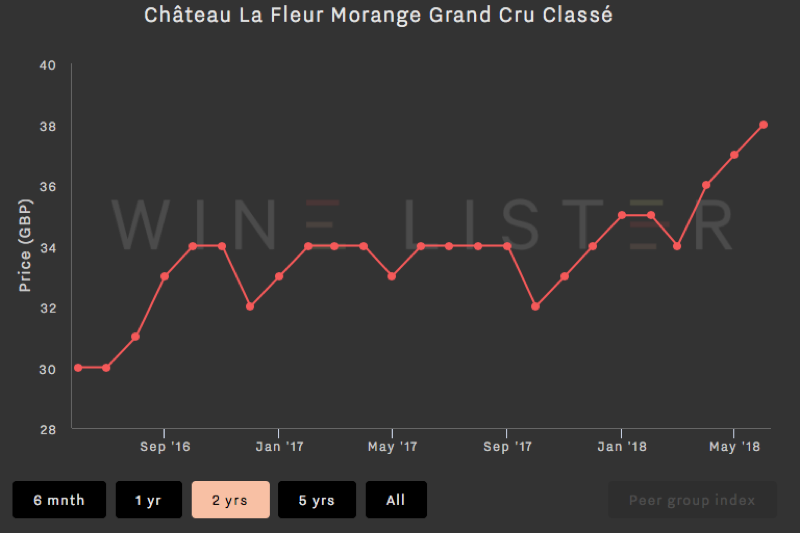
Having spent the start of the Northern Hemisphere summer focusing on Old World wines of various regions, colours, styles, and prices, this week the Listed section is feeling flush and has journeyed Down Under to take a look at Australia’s five most expensive wines.
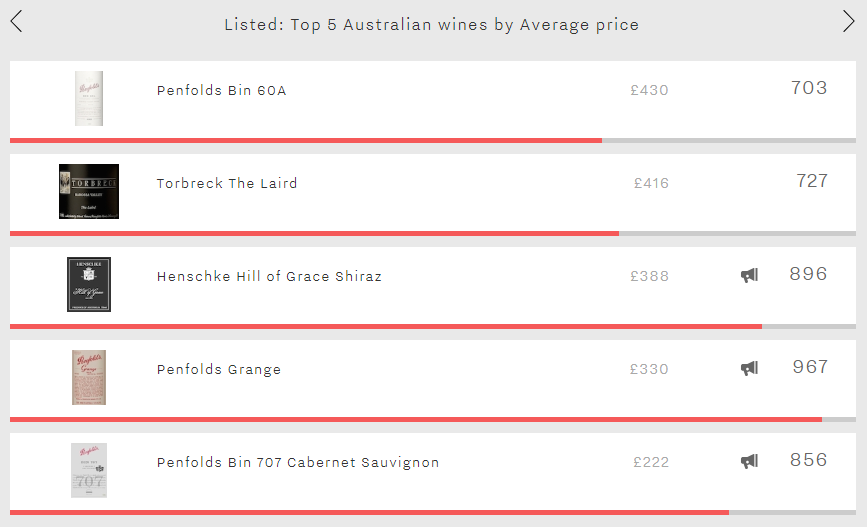
Leading the way is Penfolds Bin 60A at a cool £430 per bottle. The rarest of the rare, this has only been produced twice – once in 1962 and again in 2004 as a reaction to the vintage conditions being very similar to those from 42 years previously. As might be expected given that it is only produced in the very best vintages, the 2004 is a worthy follow-up to the fabled 1962, achieving a formidable Quality score (976). Fortunately, Wine Lister’s partner critics expect it to be drinking well until 2040, which might just give enough opportunity for a third bottling in the meantime.
Penfolds features twice more on the list, with its flagship Grange (£330) and Bin 707 Cabernet Sauvignon (£222). Grange is Australia’s strongest Brand (991) and also enjoys the country’s top Economics score (916). The former is the result of being both Australia’s best-represented wine in the world’s top restaurants (visible in 34%) and also its most popular, receiving on average 21,118 searches each month on Wine-Searcher, four times more than any other Australian wine. The Bin 707 is more of an anomaly in the group, its Quality score (859) over 100 points below the rest. Whilst its Economics score (871) can’t quite match Grange’s, it has comfortably achieved superior growth rates over the past three years, with a Compound Annual Growth Rate of 13% compared to its more renowned stablemate’s 8%.
Australia’s second most expensive wine is Torbreck’s The Laird (£416). First produced in 2005, it enjoys Australia’s best Quality score (984), but, similarly to Penfolds Bin 60A, its Brand score is unable to keep pace (635). This is probably the result of the fact that very few vintages of it are available and it has an average annual production of just 6,750 bottles each year – it is perhaps too young to have built up a significant following and there are not enough bottles of it for restaurants to get hold of.
Rounding off the group in third place is Henschke’s Hill of Grace Shiraz (£388). Again, this has an excellent average Quality score (961). It also achieves Australia’s second-best Brand score (913), present in 19% of the world’s top establishments – sommeliers are clearly very confident in the wine’s quality.
Having recently confirmed Chablis as the place to look for Burgundian Value Picks, this week’s Listed blog brings the price scale up a notch to look at the top five still dry white wines under £200 per bottle by Wine Lister score. Alongside one further appearance from Chablis, the selection is pleasantly diverse.
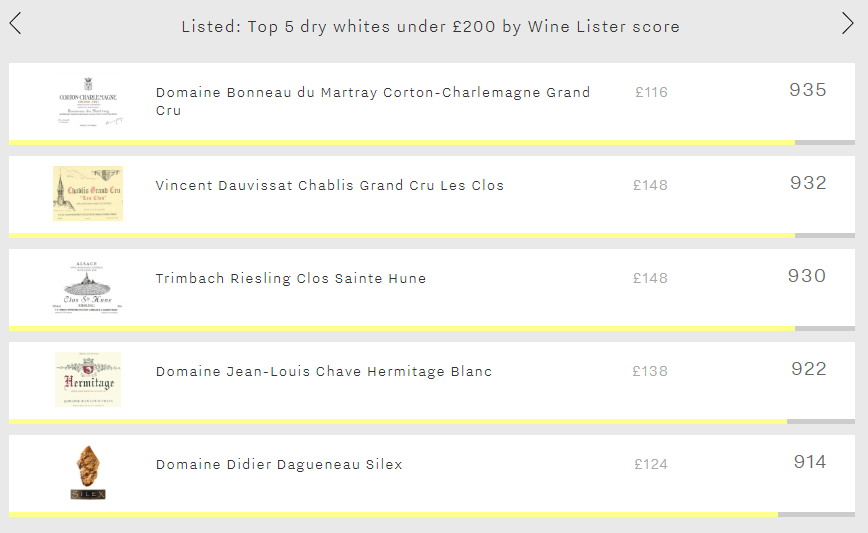
Domaine Bonneau du Martray’s Corton-Charlemagne Grand Cru takes the number one spot. With a market price of £116 per bottle, it is in fact the least expensive of the five. Brand is its strongest category with a score of 950, generated by 4,150 monthly online searches on Wine-Searcher and presence in 36 of the world’s best restaurants. Figures from Wine Market Journal also place it first for trading volumes, with 440 bottles of its top five vintages traded at auction during the last 12 months.
The second-highest scoring still dry white under £200 is Vincent Dauvissat’s Chablis Grand Cru Les Clos. It has both the highest Quality score and market price of the group (952 and £151 per bottle respectively). However, Chablis once again shows a positive price to quality ratio when compared to other white Burgundian offerings with the same Quality score. In this context, Maison Louis Jadot’s Chevalier-Montrachet Les Demoiselles and Maison Joseph Drouhin’s Montrachet Grand Cru Marquis de Laguiche are 42% and 173% more expensive (at £214 and £412 per bottle respectively).
Next on the list is Riesling Clos Sainte-Hune, Trimbach’s most iconic dry white. Its Quality and Brand scores (943 and 947 respectively) outperform its Economics score (870) resulting in an overall score of 930. Clos Sainte-Hune’s tiny production level of an average 9,600 bottles per annum (five times fewer than the 48,000 bottles of Corton-Charlemagne produced by Bonneau du Martray, for example) makes it a true rarity.
Travelling further south for the still dry white in fourth place, we find Domaine Jean-Louis Chave’s Hermitage Blanc with an overall Wine Lister score of 922. Curiously, vintage Quality score variation is more at play here than any other wine of this week’s top five. The 2016 vintage of Chave’s Hermitage Blanc earns the highest vintage Quality score of the lot (993), however 307 points separate its best from its worst vintage (2002) which is also the lowest vintage Quality score of the five.
Last but not least, the fifth highest-scoring still dry white under £200 is Domaine Didier Dageneau’s Silex, with an overall score of 914 and a market price of £124 per bottle. In a regional context, Silex takes the number one spot on all fronts with the highest Quality, Brand, and Economics scores of all Loire dry whites. As the fifth and final wine of this week’s top five, it has the highest restaurant presence with a listing in 39 of the world’s best restaurants.
Ornellaia 2015 has been released at £150 per bottle. The factsheet below summarises its key points.
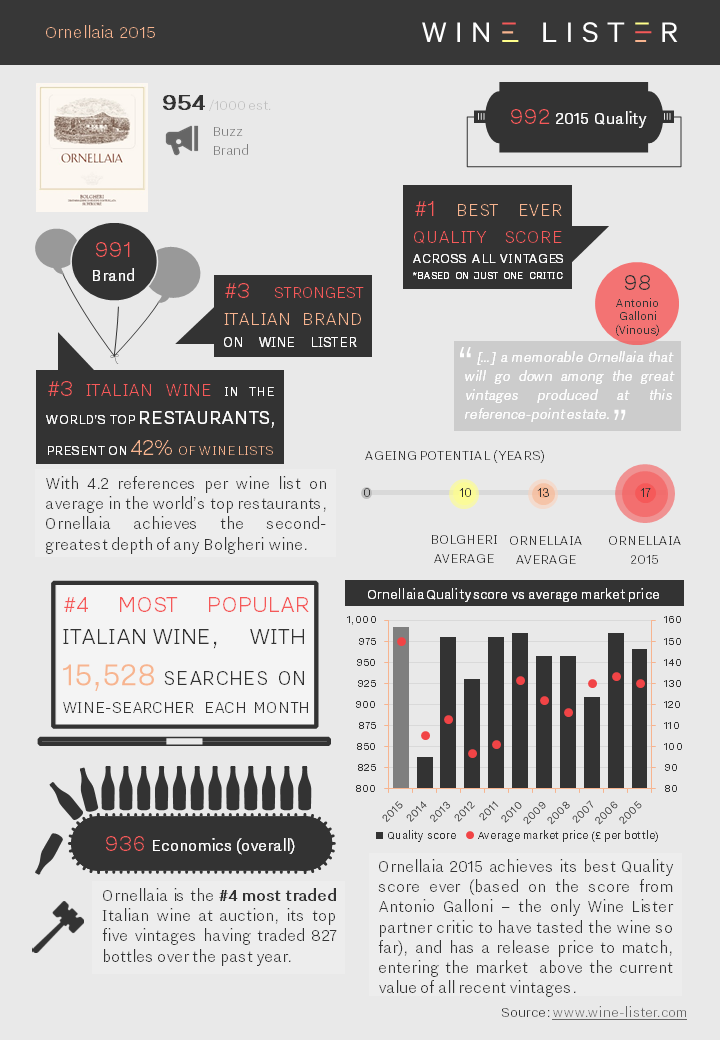
You can download this slide here: Wine Lister Factsheet Ornellaia 2015
Our in-depth study of Burgundy earlier this year showed that its prices continue to rise at a faster pace than those of any other fine wine region. With such high prices and tiny availability, wine buyers seeking good value drinking wines may often find their cellar a little light on Burgundy.
However, alongside the virtually unattainable wines at the most prestigious end of the Burgundy scale, there are some Value Picks to be found.
One of four Wine Lister Indicators, Value Picks are wines with the best quality to price ratios. Wine Lister’s proprietary Value Pick algorithm allows more expensive wines with exceptional quality to shine by reducing the impact of price in calculating the ratio.
The simple answer to good value for white Burgundy is Chablis.
For exceptional value at everyday drinking level in particular, Domaine William Fèvre stands out. Seven out of the last eight vintages of the domaine’s straight Chablis are identified as Value Picks, with prices per bottle under £13 and an average Quality score of 553 (above average on Wine Lister’s 1000-point scale).
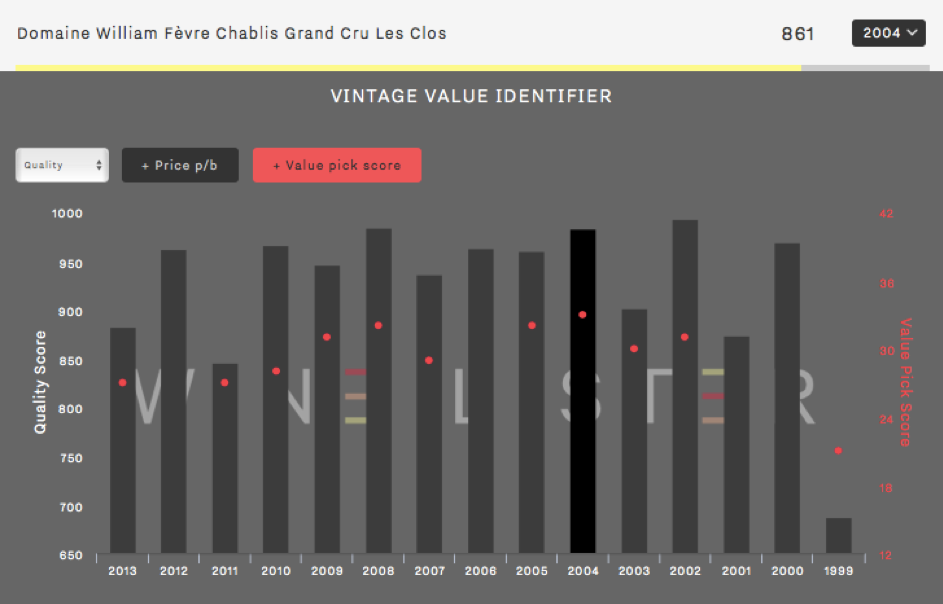
Moving up the price ladder, Domaine William Fèvre’s Chablis Grand Crus Les Clos 2004 shows exceptional value, with a price per bottle of £50 and a Quality score of 982 – shown in the Vintage Value Identifier chart above. At a comparative score (979) for white burgundy in 2004 we find Domaine Leroy’s Corton-Charlemagne Grand Cru, with a price tag 60 times higher – £3,005 per bottle.
Chablis make up all top 10 white Burgundy Value Picks.
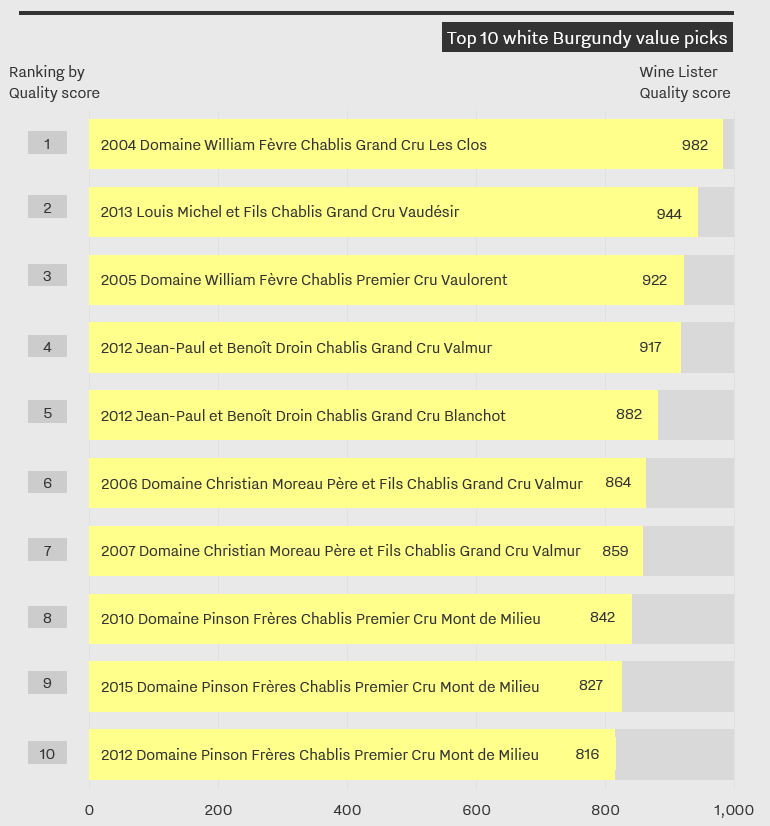
The Burgundian Value Pick with the highest Quality score is in fact a red – Domaine de la Pousse d’Or’s Volnay Premier Cru Clos de la Bousse d’Or 1995. At c.£50 per bottle and a Quality score of 983, it earns the highest Quality score for Volnay, and the third-highest for Burgundy’s 1995 vintage (after Méo-Camuzet’s Vosne Romanée Cros Parantoux and Rousseau’s Chambertin Grand Cru, priced at £1,046 and £1,448 respectively). Any lucky owners of the Clos de la Bousse d’Or 1995 should open and enjoy it now. Wine Lister partner critic, Jancis Robinson, puts its drinking window between 2006 and 2019.
As July begins, much of the wine world may feel more grey and drizzly than the weather would suggest, due to a case of post-primeurs blues. Indeed, Wine Lister’s founder, Ella Lister, reports in her recent article for JancisRobinson.com that “…the majority of merchants are reporting revenues down approximately two-thirds on 2016”. In that article, a comparison of Quality scores across recent vintages highlights the value proposition of the 2014 vintage. In this blog post we dig a bit deeper.
A few weeks into this year’s en primeur campaign releases, the Wine Lister team noticed a distinct pattern. With almost every new release, we sounded more and more like broken records, echoing that château X’s 2017 release price, while below the last two vintages, made the 2014 look like good value. While it has been pigeonholed as a good but not great vintage, 2014 achieved consistently high critics’ scores that imply its reputation should be better.
The chart below shows Bordeaux 2014 and 2017 average Quality scores by appellation, comparing 2014 three-month average prices with 2017 release prices.
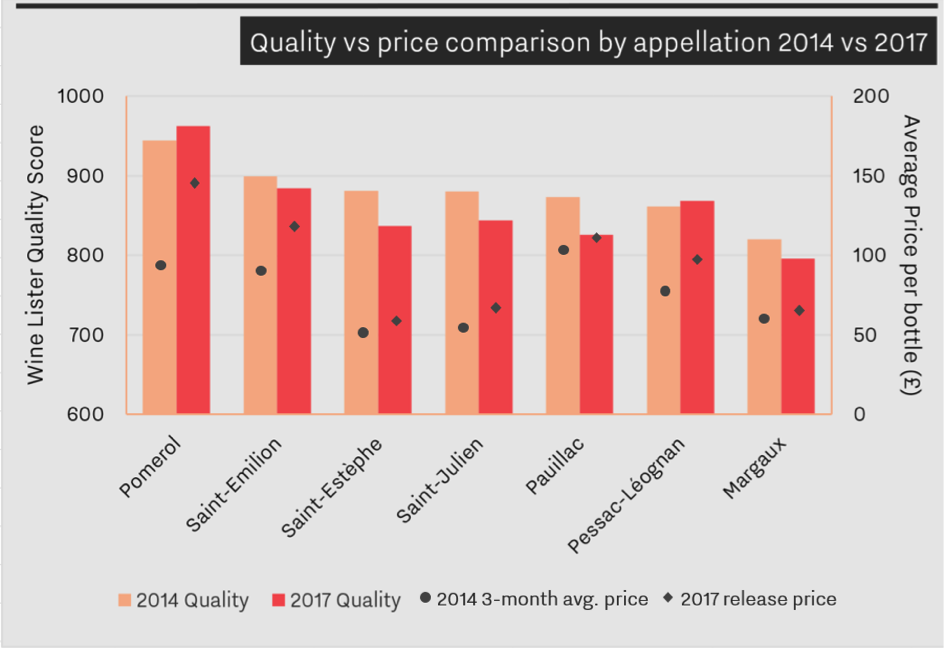
Based on 75 key Bordeaux classified growths, the chart illustrates the relationship between quality and price (note the price gap for 2014 and 2017 Saint-Émilion, despite similar average Quality scores). Only Pomerol and Pessac-Léognan achieved higher Quality scores on average in 2017 than in 2014, with Wine Lister’s partner critics preferring 2014 across all other appellations.
While the trade puts aside its allocations of 2017 for the time being, perhaps the silver lining is the light this vintage shines on relative value elsewhere. Is it time for merchants and collectors alike to focus on 2014?

We used Wine Lister’s comparison tool in our search for good-value back vintages in order to compare different vintages and their respective critics’ scores and prices. For example, Malescot Saint-Exupéry achieves a Quality score of 894 in 2014, versus 735 in 2017. Despite the substantial price reduction on the 2016 and 2015 vintages, the 2017 UK market price remains 5% higher than the 2014, the latter receiving higher scores from three of the four Wine Lister partner critics. Neal Martin disagrees, awarding the 2017 a potential 2 points more than 2014 saying, “it is not a complex Malescot St. Exupéry, but I admire the balance and focus”.
Malescot Saint-Exupéry 2014 has the highest Value Pick score of any recent vintage:
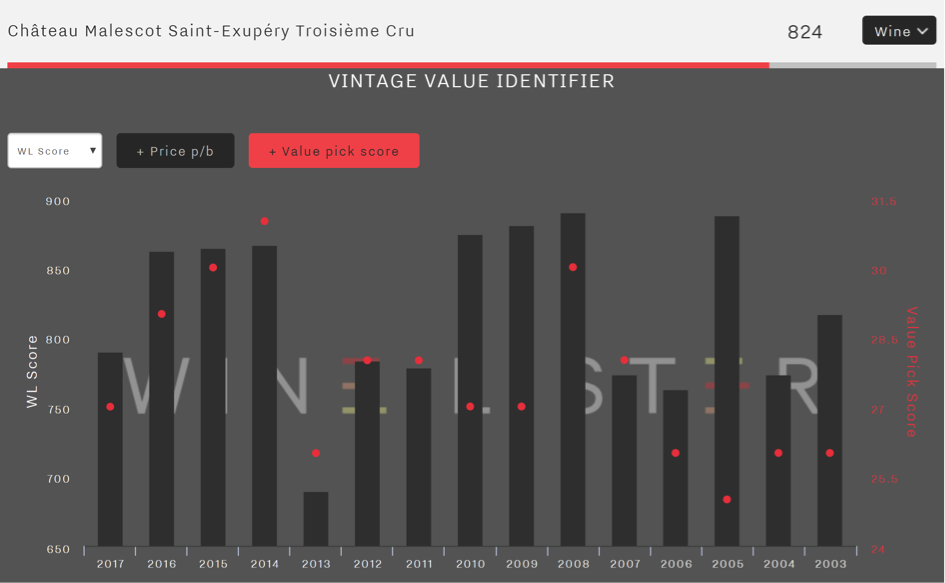
Use the Vintage Value Identifier chart (pictured above) on every wine page to pick out the best value back vintages. For example, Cantenac-Brown’s 2014 looks like a particularly good buy, at £25.50 per bottle for the 2014 (whose Quality score is 800), versus the 2017 at £34.05 per bottle, with a Quality score of 715. Its 2015 looks good too.
As a sort of postscript to the difficult 2017 en primeur campaign (read our CEO Ella’s thoughts here), over the past week or so Pomerol powerhouses Petrus and Le Pin were released at £1,480 and £1,750 per bottle respectively. With Pomerol wines achieving the top three Quality scores of all reds for 2017 – and five of the top 10 – it was the top-performing red appellation of the vintage.
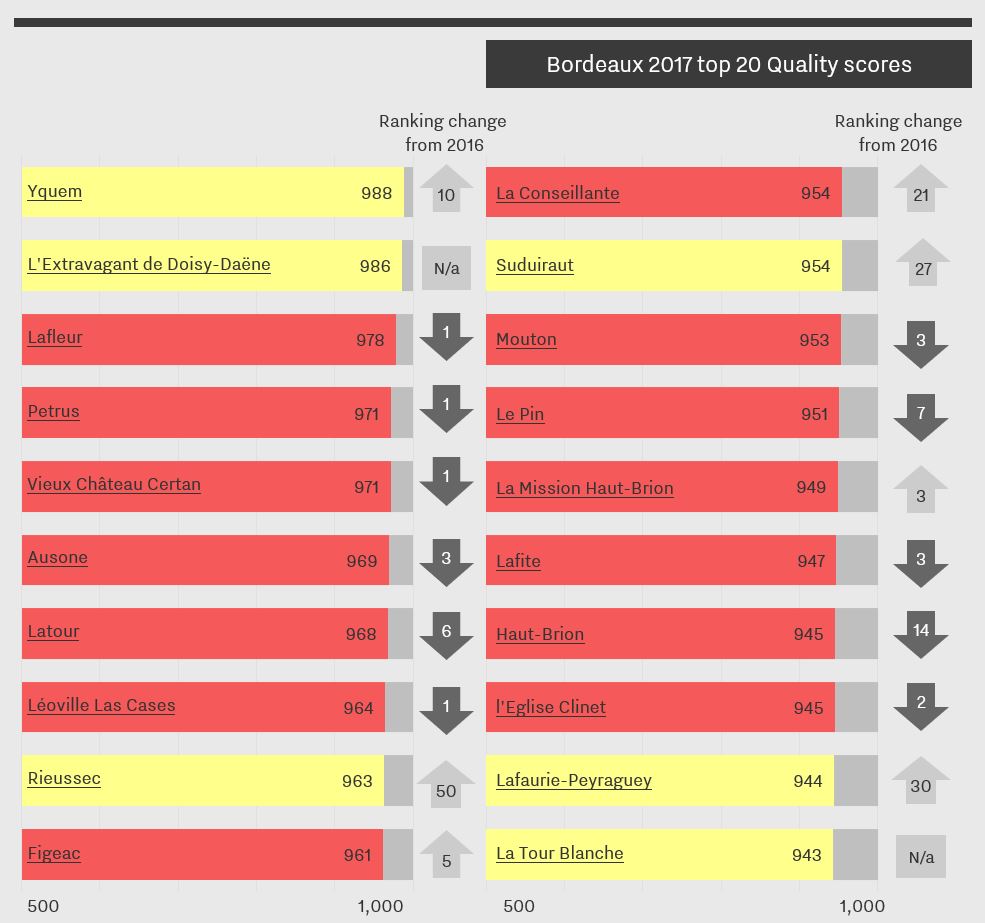
Now that we have release prices for all of Pomerol’s top wines, we can see which came out on top in terms of overall Wine Lister score*.
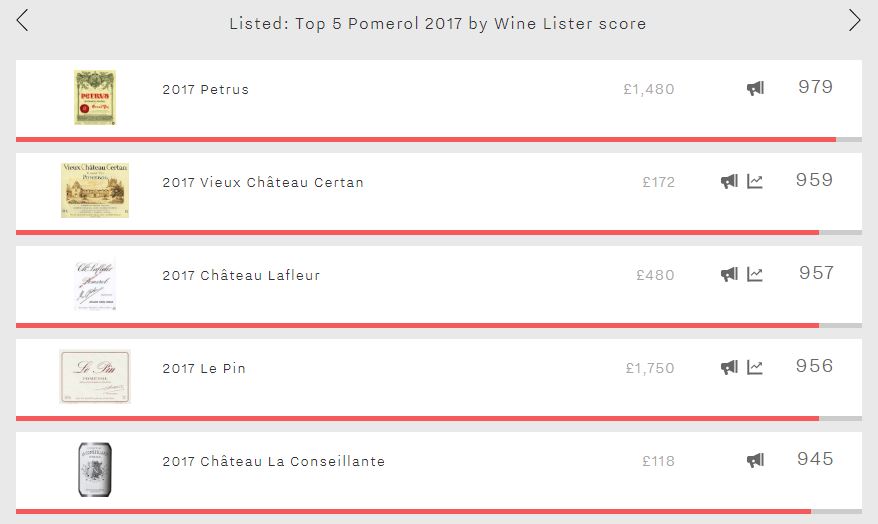
With a score of 979, Petrus was not just Pomerol’s leading wine of 2017, but the number one wine in Bordeaux. This is perhaps unsurprising given that it received the joint-second best Quality score of the vintage of all reds (971) – alongside Vieux Château Certan – and also has a Brand score of 998 (beaten only by Lafite, Latour, Mouton, Yquem, and Dom Pérignon Vintage Brut) along with a wine-level Economics score of 978 (third-best in Bordeaux). With Wine Lister’s Founding Members voting it the second-most prestigious wine in the world in a recent survey, behind DRC La Romanée-Conti, Petrus is currently unbeatable in Bordeaux.
Number two on the 2017 Pomerol leaderboard is Vieux Château Certan (959). While the confidence rating attributed by Wine Lister’s Founding Members slipped a point over the past year from 9/10 to 8/10, it nevertheless achieves Pomerol’s second-best Brand score (972). Thus, despite its relatively modest Economics score (909) – still putting it amongst the very best on Wine Lister’s 1,000 point scale – the 2017, thanks to its excellent Quality score, manages to edge just ahead of Lafleur in terms of overall Wine Lister score (957).
Lafleur 2017, the best red wine of the vintage for Quality (978), was released in early May at £430 per bottle, a 7% decrease on the 2016 release price. This was Neal Martin’s favourite of the five, Wine Lister’s newest partner critic awarding it a score of 95-97 /100 and commenting: “This is an awesome 2017 from Baptiste Guinaudeau, one of the few that will oblige several years in the cellar”.
Le Pin 2017 was released in the UK at £1,750 per bottle, its 25% decrease on the 2016 release price the largest year-on-year reduction of the five. It experiences the lowest Quality score of the five for the vintage (951), and also has the group’s lowest Brand score (944). The fact that the 2017 betters Lafleur and La Conseillante in terms of overall Wine Lister score is thus the result of its formidable Economics score (980), which it achieves not just because of its high average price but also strong growth rates, which are the best of the group over both the long and short-term.
Rounding out the group is La Conseillante (945). Whilst it is by far the most affordable of the group, it is the only one of the five whose 2017 climbed the Bordeaux Quality score table compared to 2016, surging 21 spots to be the eighth best red and 11th best overall.
Remember that you can catch up on all of the campaign’s releases on our dedicated en primeur page.
* Please note that overall Wine Lister scores for en primeur wines use estimated Economics scores based on the performance of back vintages.
Petrus 2017 was released in the UK at £1480 per bottle (19% down on 2016), with a lower Quality score: 971 (vs 991).
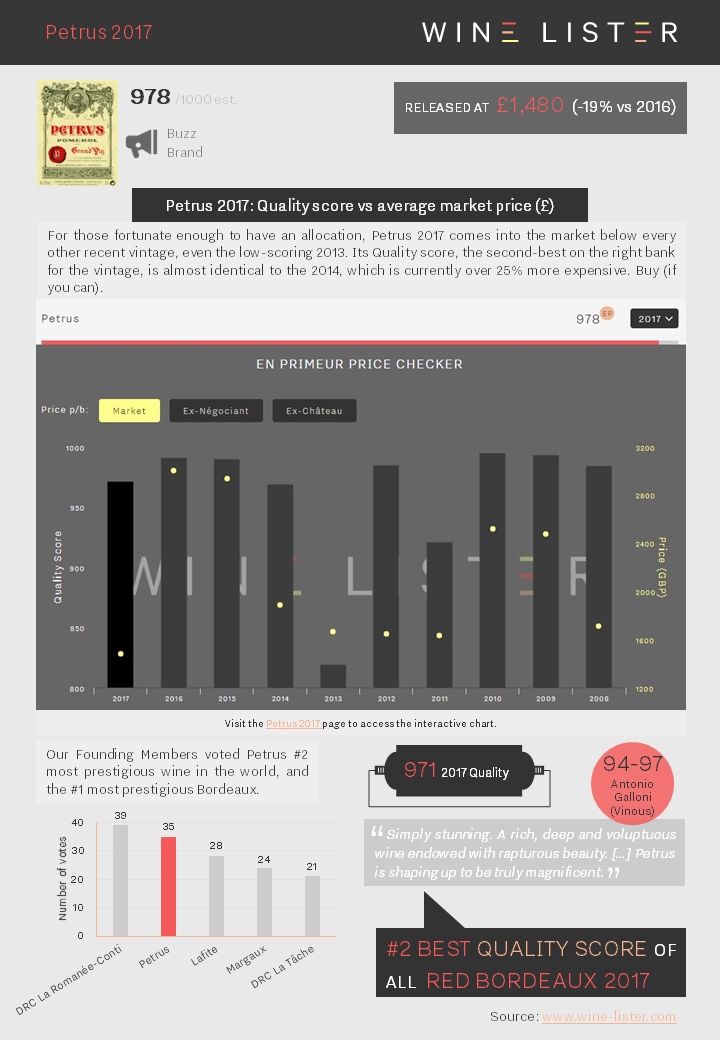
You can download the slide here: Wine Lister Factsheet Petrus 2017
What do you do when your drinking tastes far outweigh your wine budget? You could trawl the shops and the internet in search of that bottle that combines high ratings and moderate prices, or alternatively you could use Wine Lister’s Value Picks search tool. It selects top quality wines that are available at reasonable prices, doing the legwork for you. This week’s Listed section shines a spotlight on the top five reds that currently qualify as Value Picks. At present, they are all Tuscan, all available for under £90 – in fact all but one cost less than £50 – and all have Quality scores of over 990, putting them amongst the elitest of the elite on Wine Lister’s 1,000 point scale.
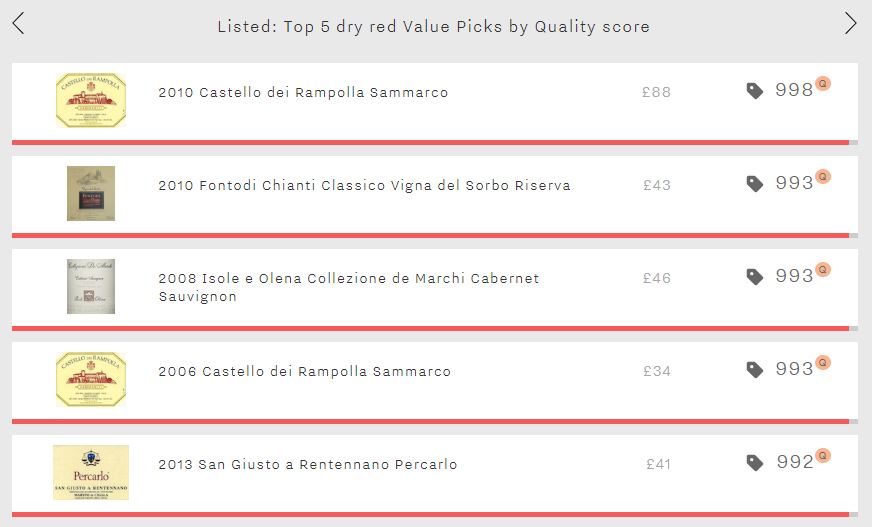
If you are after exceptional value, then look no further than Castello dei Rampolla’s Sammarco. With two vintages in the top five (2010 and 2006), each of which have plenty of life still left in them, they look like wise purchases. The 2010 owes its exceptional Quality score to a perfect 100-point rating from Wine Lister partner critic Antonio Galloni, who called it “stunning as it has always been. In a word: magnificent!”. At £88 per bottle, it might not be the cheapest, but it does look good value compared to the two other 998-point scorers from Tuscany 2010: Cerbaiona Brunello di Montalcino (£248) and Castello dei Rampolla’s Alceo (£128).
Whilst the 2010 is not quite ready to drink, the 2006 has just entered its drinking window. Underlining the wine’s longevity, Galloni, who awarded the wine a 97-point score, remarked: “Readers will have to be exceedingly patient here. There is no denying the 2006’s greatness, though.” The 2006 will be drinking well until 2036, and available for as little as £34 per bottle, looks like an excellent long-term investment (if you can refrain from opening it).
Flying the flag for Chianti is Fontodi’s best ever Chianti Classico Vigna del Sorbo Riserva – the 2010 (£43). Whilst its Quality is not in doubt, its economic performance is slightly less impressive, its price having fallen 11% over the past six months.
The remaining spots are filled by Isole e Olena Collezione de Marchi Cabernet Sauvignon 2008 (£46) and San Giusto a Rentennano Percarlo 2013 (£41). Isole e Olena Collezione de Marchi 2010’s Quality score is the furthest above its wine-level average Quality score (993 vs 934) of the five. The market has not yet reacted to this standout vintage, its price being no different to the wine-level average price. Meanwhile San Giusto a Rentennano Percarlo 2013’s Quality score is the closest to its (formidable) wine-level average (992 vs 967), yet its price is 36% below the wine-level average, underlining the 2013’s excellent value.
Please note that prices shown are excluding duty and VAT, and often reflect prices available only when purchasing a full case. They are provided by our price partner, Wine Owners, whose own proprietary algorithms process millions of rows of incoming price data from Wine-Searcher to calculate a more realistic market level price – the price at which a wine is likely to find a ready buyer – based on market supply and spread models. As lower retail prices are likely to sell first, the prices you see on Wine Lister may be below the Wine-Searcher average in some instances.
All the facts on Cristal 2008 which has been released today with its best ever Quality score (996).
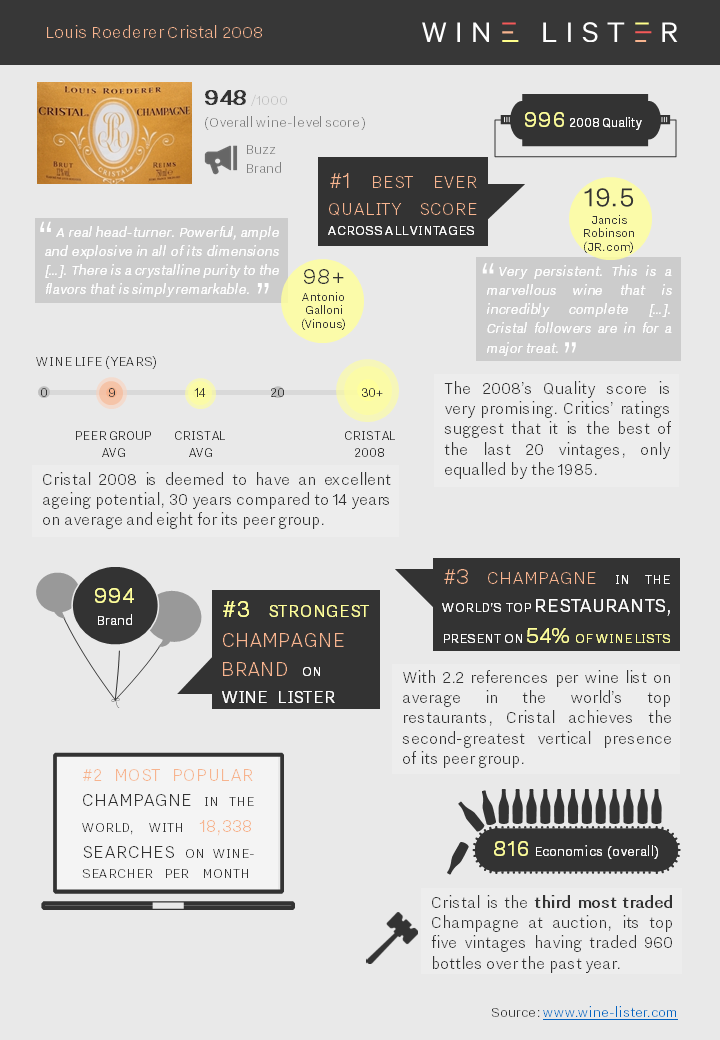
You can download the slide here: Wine Lister Factsheet Cristal 2008
















